Related Research Articles

Kutch district, officially spelled Kachchh, is a district of Gujarat state in western India, with its headquarters (capital) at Bhuj. Covering an area of 45,674 km2, it is the largest district of India. The area of Kutch is larger than the entire area of other Indian states like Haryana (44,212 km2) and Kerala (38,863 km2), as well as the country of Estonia (45,335 km2). The population of Kutch is about 2,092,371. It has 10 talukas, 939 villages and 6 municipalities. The Kutch district is home to the Kutchi people who speak the Kutchi language.

Jamnagar is a city and the headquarters of Jamnagar district in the Indian state of Gujarat. The city lies just to the south of the Gulf of Kutch, some 337 kilometres (209 mi) west of the state capital, Gandhinagar.

Jamnagar District is a district of Gujarat in Western India. Its headquarters are located in the eponymous city of Jamnagar. It hosts the production facilities of large Indian companies such as Reliance. Among its attractions are several palaces, a Marine National Park and a Bird Sanctuary, known as Khijadiya Bird Sanctuary. In 2013, Devbhoomi Dwarka district was carved out of the western part of the district.

Jadeja is a Samma Rajput clan that inhabits the Indian state of Gujarat and the Tharparkar district of Sindh, Pakistan. They originated from Sammas of Sindh, a pastoral group, and laid a claim on the Rajput identity after marriages with Sodha Rajput women by adopting a process called Rajputisation.
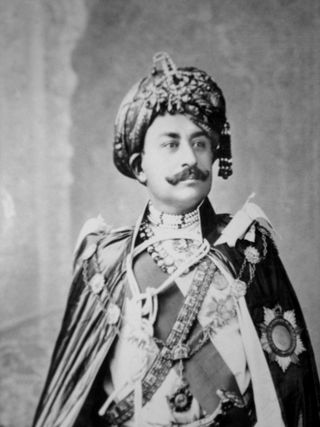
Maharajadhiraj Mirza Maharao Sir Khengarji III Sawai Bahadur was a progressive and one of the longest ruling monarchs and also the longest ruling king of the Princely State of Kutch from 1875 to 1942.
Palanswa or Palansva is a village of Vaghela Royal kingdom in Gujarat, India.Its one and only Vaghela Jagir(Kingdom) in kutch others are of Jadeja's Jagir(Kingdom). The Palasva's Fort have permission of Jail. Palasva also known as King Meghrajsinh Vaghela's place and palace. It lies in the Kutch district in the Taluka of Raapar. The village is located on Indian National Highway No 8A.
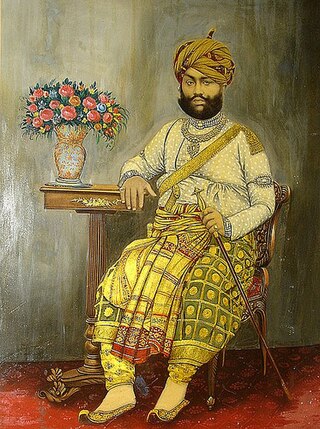
HH Maharajadhiraj Mirza Maharao Shri Sir Pragmalji II Saheb Bahadur, (1839−1875) was the ruler of Cutch State, belonging to the Jadeja dynasty who ascended the throne upon death of his father & predecessor Rao Deshalji II on 26 July 1860 and ruled till his death on 19 December 1875.
Hamirsar Lake is a man-made lake situated in the centre of Bhuj, the headquarters of Kutch district (Kachchh) in the Indian state of Gujarat.
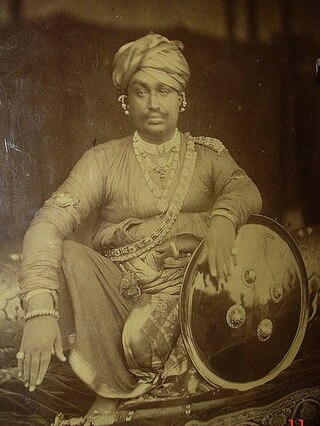
Maharajadhiraj Mirza Maharao Shri Deshalji II Sahib Bahadur was the Rao of Cutch belonging to Jadeja dynasty, who ascended the throne of Princely State of Cutch upon deposition of his father Bharmalji II by British. He reigned during his minority, under a Council of Regency, headed by Captain MacMurdo and composed of Jadeja chiefs.
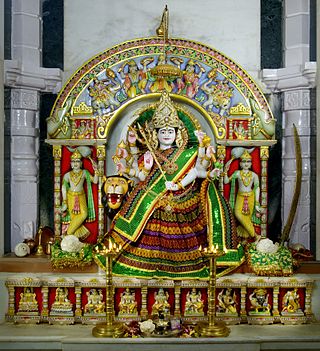
Ashapura Mata is an aspect of Devi, a Hindu goddess. She is one of the kuldevis of Kutch and Rajasthan, and the Jadeja clan of Gujarat, Chauhans and Patiyats inhabiting the western Indian provinces. She is a goddess regarded to fulfill the wishes of her adherents.

Cutch State, also spelled Kutch or Kachchh and also historically known as the Kingdom of Kutch, was a kingdom in the Kutch region from 1147 to 1819 and a princely state under British rule from 1819 to 1947. Its territories covered the present day Kutch region of Gujarat north of the Gulf of Kutch. Bordered by Sindh in the north, Cutch State was one of the few princely states with a coastline.

Jam Rawal Lakh (1480–1562), was a Jadeja Rajput ruler, who ruled Kutch State from 1524 to 1548 and later was founder-ruler of Nawanagar State from 1540 to 1562.

Morvi State, also spelled as Morvee State or Morbi State, was a princely salute state in the historical Halar prant (district) of Kathiawar during the British Raj.
Maharajadhiraj Mirza Maharao Bharmalji II was the Rao of Cutch belonging to Rajput dynasty, who ascended the throne of Princely State of Cutch one month after the death of his father Rayadhan III.
Bar Bhayat ni Jamat was a council of twelve members which managed Cutch State under titular kings Prithvirajji from 1786 to 1801 and under Rayadhan III from 1801 to 1813. The council was chiefly led by Fateh Muhammad during both period. The council is also known as Bar Bhayyat or Bar Bhaya.
Rao Deshalji I was the Rao of Cutch belonging to Jadeja Rajput dynasty, who ruled Princely State of Cutch as a regent from 1718 1752. His son Lakhpatji confined him in 1741 and ruled as a regent until death of Deshalji in 1752.
Rao Pragmalji I was the Rao of Cutch belonging to Jadeja Rajput dynasty, who ruled Princely State of Cutch as from 1698 to 1715. He established current lineage of rulers of the state in 1698.
Captain James MacMurdo was the first political resident of British East India Company to Cutch State. He played important role in bringing kutchh under British suzerainty.
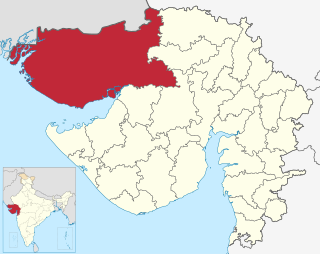
The history of Kutch, (kachchh) a region in the extreme west of the western Indian state of Gujarat, can be traced back to prehistorical times. There are several sites related to Indus valley civilization in region and is mentioned in Hindu mythology. In historical times, Kutch is mentioned in Greek writings during Alexander. It was ruled by Menander I of Greco-Bactrian Kingdom which was overthrown by Indo-Scythians followed by Maurya Empire and Sakas. in the first century, it was under Western Satraps followed by Gupta Empire. By fifth century, Maitraka of Valabhi took over from which its close association with ruling clans of Gujarat started. Chavdas ruled the eastern and central parts by seventh century but then came under Chaulukyas by tenth century. After fall of Chaulukya, Vaghelas ruled the state. Following conquest of Sindh by Muslim rulers, Rajput Samma started moving southwards to Kutch and ruled western regions initially. By tenth century, they controlled significant area of Kutch and by thirteenth century they controlled whole of Kutch and adopted a new dynastic identity, Jadeja.
Jam or may called Ja'am is a native title of rulers of a few princely states, notably born in western British India by the Samaa dynasty and their Jadeja branch which denotes their claimed descent from the legendary Jamshed of Iran.
References
- ↑ Jhala, Jayasinhji (19 July 2018). Genealogy, Archive, Image: Interpreting Dynastic History in Western India, c. 1090–2016. Walter de Gruyter GmbH & Co KG. ISBN 978-3-11-060129-9.
- ↑ Ward (1998). Gujarat–Daman–Diu: A Travel Guide. Orient Longman Limited. ISBN 978-81-250-1383-9.
- 1 2 The Land of 'Ranji' and 'Duleep', by Charles A. Kincaid by Charles Augustus Kincaid. William Blackwood & Sons, Limited. 1931. pp. 11–15.
- 1 2 3 Imperial Gazetteer 2 of India, Volumen 11,. 1908. pp. 75–80.
- 1 2 Gujarat State Gazetteers: Junagadh by Gujarat (India) - 1971 - Page 79
- ↑ The Paramount Power and the Princely States of India, 1858-1881 - Page 287
- ↑ Special issue to honor the centenary celebrations of the ... - Page 2 by S. K. Bhowmik - 1977
- ↑ The Rajputs: history, clans, culture, and nobility by Rānā Muḥammad Sarvar K̲h̲ān̲ 2005- Page 174.
- ↑ Gazetteer of the Bombay Presidency ... - Volume 9, Part 1, 1901 - Page 126
- ↑ Mcleod, John (6–9 July 2004). The Rise and Fall of the Kutch Bhayati (PDF). Eighteenth European Conference on Modern South Asian Studies, University of Lund. pp. 1–5. Archived from the original (PDF) on 7 March 2012. Retrieved 13 September 2012.